If you have been trying to lose weight, chances are you’ve spent a lot of time researching what foods to eat. But if you’re like many dieters, you may be struggling to come up with healthy – and delicious – meals that not only taste good but also are low-calorie so that they don’t cause weight gain. That’s why we’re here to help: we have gathered the top meals for your weight-loss success.
Eating healthier often means cutting back on calories – volume-based diets like this one offer a great way to add both nutrition and flavor into your diet without overdoing it on the calorie count. By following these meal plans specifically tailored to helping people lose weight without sacrificing volume or flavor, you can potentially reduce this calorie intake significantly.
After all, reducing your daily caloric intake by 500 can result in a loss of up to 1 pound per week. Which amounts to an impressive 52 pounds lost over just one year.
Losing weight isn’t always easy – which is why our goal here is to make sure it doesn’t have to be boring either! By incorporating these recipes into your routine, not only will you be able to feel fuller after each meal but enjoy them too! Let’s get started!
Table of Contents:
- Part 1: Understanding High-Volume, Low-Calorie Eating
- Part 2: Essentials for High-Volume, Low-Calorie Cooking
- Part 3: Your 10 Meal Plan for Weight Loss
- Part 4: Tips for Maximizing Fullness and Flavor
Understanding High-Volume, Low-Calorie Eating
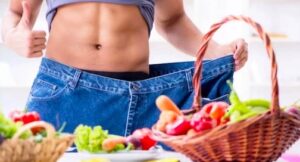
As well as containing fewer calories than other foods, high volume low-calorie foods generally contain more fiber per calorie which helps to satisfy our hunger for longer periods, regulating blood sugar levels.
Filling up on nutrient-dense food such as vegetables is an ideal way for health-conscious individuals to reach their goals while still being able to enjoy good food. Diets higher in low energy density were associated with a greater quantity of fruits and vegetables consumed. This supports the idea that diets focused on increased satiety through larger meal sizes have potential benefits related to improved dietary quality.
Additionally, high volume low-calorie foods can maintain lean muscle mass while still providing overall caloric reduction – aiding in fat loss. Eating more protein can help curb cravings due to its positive influence on the hunger hormones leptin and ghrelin while simultaneously helping sustain muscle tissue during periods of calorie restriction.
Essentials for High-Volume, Low-Calorie Cooking
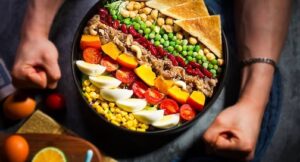
When engaging in high-volume, low-calorie eating, it is essential to select good quality whole foods that are nutrient-dense and provide sufficient nourishment. Start by filling your plate with vegetables. These can be steam-cooked, stir-fried, or roasted– whichever way you like them best. Also add legumes such as chickpeas and lentils, or some quinoa which is a great source of plant-based protein as well as fiber. Additionally, nuts are also an excellent option to boost nutrition as well as add flavor.
Non-starchy vegetables such as leafy greens, broccoli, and cauliflower take up more space per calorie compared to starchy options like potatoes and rice. Consumption of non-starchy veggies has been associated with reduced risk factors for cardiovascular diseases. To pair with the veggies it’s important to choose lean proteins such high quality meat cuts including chicken breast or pork loin – both of which contain fewer calories than other types of meats. For longer-lasting energy opt for complex carbohydrates including oats or sweet potatoes – they take longer to digest providing sustained energy throughout the day.
Adding herbs and spices not only helps add great flavor without providing extra calories but can have various health benefits too due to their antioxidant content. According to research garlic was found to enhance satiety. The use of slightly acidic ingredients including lemon juice could potentially help enhance digestion since an optimal pH level within our gut flora is generally between 6 and 7.
Finally, there are various ways you can make meals more interesting such as using salt substitutes that include potassium chloride instead of sodium chloride or making delicious savory snacks that don’t contain added sugar, one popular option includes air-popped popcorn topped with just a pinch of Himalayan rock salt.
In conclusion, when attempting weight loss through high-volume calorie eating few simple rules need to be followed – pick nutrient-dense whole foods that don’t contain added sugar/fat while also choosing lean proteins along with complex carbohydrates paired together with nonstarchy veggies. Finally, always season your meals appropriately so you get the maximum taste without piling too many extras onto your plate.
Your 10 Meal Plan for Weight Loss
In this section, we will present some examples of high-volume low-calorie meals that can help you lose weight. The top priority when looking at meal options should be ensuring that there is a balance between high volume and lower calorie density. Examples include:
-
Stir Fried Chicken & Vegetables
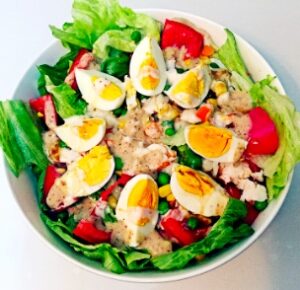 Start by marinating chicken cubes in a mix of low-sodium soy sauce, rice vinegar, sesame oil, and ginger. Then stir fry with onion, garlic, bell peppers, and mushrooms as desired. Serve over steamed or boiled quinoa to enhance the protein content.
Start by marinating chicken cubes in a mix of low-sodium soy sauce, rice vinegar, sesame oil, and ginger. Then stir fry with onion, garlic, bell peppers, and mushrooms as desired. Serve over steamed or boiled quinoa to enhance the protein content.
-
Baked Salmon & Mediterranean Salad
For a light lunch idea bake a salmon filet topped with herbs such as oregano or thyme along with olive oil at 180 degrees Celsius for around 20 minutes then toss together a salad made from kale leaves, diced cucumber/celery/tomatoes, and feta cheese, top off with fresh lemon juice for added flavor! Vegan alternatives include roasted butternut squash or eggplant instead of fish depending on preferences – these would pair nicely with lentil or chickpea salads too!
-
Avocado Toast & Poached Egg
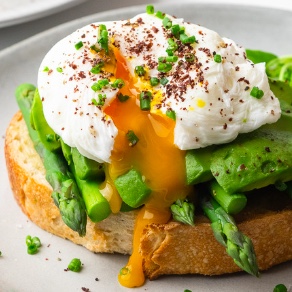 Combine two slices of toasted whole wheat bread spread with ripe avocado slices, sprinkle some freshly cracked black pepper over it then top off the dish with a poached egg to provide extra protein and satiety while keeping overall calorie count low. Additionally, this dish can be tweaked according to personal preferences – instead of the toast use steamed sweet potato slices if desired!
Combine two slices of toasted whole wheat bread spread with ripe avocado slices, sprinkle some freshly cracked black pepper over it then top off the dish with a poached egg to provide extra protein and satiety while keeping overall calorie count low. Additionally, this dish can be tweaked according to personal preferences – instead of the toast use steamed sweet potato slices if desired!
-
Overnight Oats
A perfect breakfast option is overnight oats prepared from half a cup of oats mixed with plain Greek yogurt and one teaspoon of honey before stirring in diced apples/bananas/berries accordingly, leave this in the fridge overnight until ready to enjoy the first thing in the morning! This will provide loads of energy throughout the morning period without being overly calorific like other breakfast recipes!
-
Veggie Burger Wraps
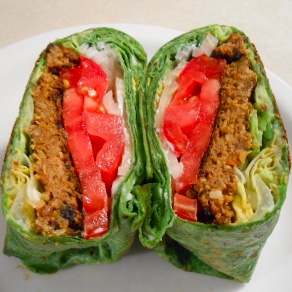 Slice up mushrooms grilled alongside bell peppers placed within flour tortilla wraps along with add-ons such as lettuce leaves/onion slices filled inside. To keep it healthier try swapping out regular burger buns for lettuce wraps instead – just remember not to heat them too long on a pan since they dry out faster than larger buns do! A vegan alternative could involve using quinoa patties instead which offer more fiber content too.
Slice up mushrooms grilled alongside bell peppers placed within flour tortilla wraps along with add-ons such as lettuce leaves/onion slices filled inside. To keep it healthier try swapping out regular burger buns for lettuce wraps instead – just remember not to heat them too long on a pan since they dry out faster than larger buns do! A vegan alternative could involve using quinoa patties instead which offer more fiber content too.
-
Quinoa Bowls
Prepare quinoa by combining it in one pot alongside vegetables such as carrots/onions while simmering everything together until cooked through followed by adding spices such as curry powder/garlic powder, etc before serving accompanied by salad greens topped off with your favorite dressing choice! Another option would be cubed tofu for added protein.
-
Zucchini Noodles With Shrimp
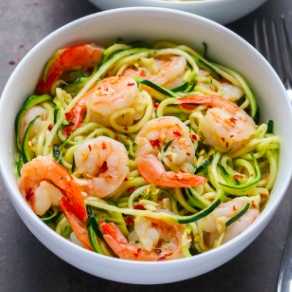 Spiralize zucchini noodles then lightly sauté them alongside shrimp seasoned however you prefer, serve hot, and add freshly chopped herbs like parsley leaves when planting for a final touchup If preferred swap out the shrimp part for leaner cooked chicken strips instead! A vegan alternative could use mini portobello mushrooms stir-fried alongside zucchini noodles.
Spiralize zucchini noodles then lightly sauté them alongside shrimp seasoned however you prefer, serve hot, and add freshly chopped herbs like parsley leaves when planting for a final touchup If preferred swap out the shrimp part for leaner cooked chicken strips instead! A vegan alternative could use mini portobello mushrooms stir-fried alongside zucchini noodles.
-
Greek Yogurt Popsicles
An excellent snack idea involves taking plain Greek yogurt and blending it with fresh diced strawberries/blackberries. Pour this into popsicle molds and freeze overnight – perfect for lunchtime or an after-dinner evening treat! If you’d like a chocolate version, mix in cocoa powder as well. Top off each popsicle with a few rolled oats for added fiber before freezing them!
-
Curried Lentil Soup
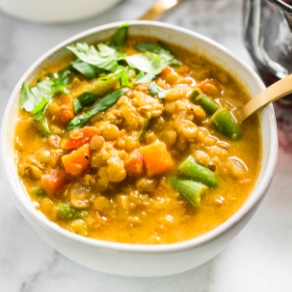 Start by sautéing onion until translucent followed by adding garlic & ginger paste and then add spices of choice such as cumin/coriander powder along with turmeric and chili flakes if desired. When fragrant add in precooked lentils before pouring in vegetable stock of your preference ready to simmer for 15 minutes or more so all flavors blend nicely.
Start by sautéing onion until translucent followed by adding garlic & ginger paste and then add spices of choice such as cumin/coriander powder along with turmeric and chili flakes if desired. When fragrant add in precooked lentils before pouring in vegetable stock of your preference ready to simmer for 15 minutes or more so all flavors blend nicely.
-
Feta & Chickpea Salad
Preparing this salad requires mixing cubed feta cheese, canned chickpeas, cherry tomatoes, cucumber slices, and sliced olives into a large bowl before tossing everything together alongside some finely chopped onions and parsley leaves. Finish the salad by drizzling extra virgin olive oil to enhance taste alongside freshly squeezed lemon juice as dressing!
Tips for Maximizing Fullness and Flavor
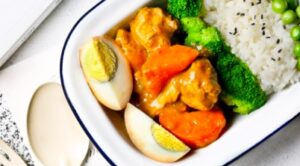 When attempting to maximize fullness and flavor with your high-volume, low-calorie meals there are certain tricks you can use to make every bite count! Firstly season your food appropriately, try using herbs, spices, and salt substitutes within recipes while also introducing nutty or zesty flavors through additions such as nuts or lemon juice. Likewise, a small drizzle of olive oil over roasted vegetables will add flavor without adding too many extra calories. Additionally opt for larger portion sizes as the fiber-rich content generally found in most high-volume low-calorie foods will help reduce hunger cravings throughout the day.
When attempting to maximize fullness and flavor with your high-volume, low-calorie meals there are certain tricks you can use to make every bite count! Firstly season your food appropriately, try using herbs, spices, and salt substitutes within recipes while also introducing nutty or zesty flavors through additions such as nuts or lemon juice. Likewise, a small drizzle of olive oil over roasted vegetables will add flavor without adding too many extra calories. Additionally opt for larger portion sizes as the fiber-rich content generally found in most high-volume low-calorie foods will help reduce hunger cravings throughout the day.
Finally, another key factor when looking at fullness & flavor is texture. Crisp vegetables like carrots or radishes are perfect when eaten raw whereas slightly softer ones including cooked broccoli can be better enjoyed in hot dishes. Consuming both cooked and raw foods adds contrast which stimulates our senses creating more delicious flavored meals offering ultimate satisfaction! To further enhance taste look into making healthy ingredient swaps such as replacing white rice pasta varieties with wholewheat pasta that have double the fiber content.
Conclusion
Achieving weight loss goals while maximizing the fullness and flavor potential offered by high-volume low-calorie meals is possible using the various tips discussed above. Choose nutrient-dense whole foods that you enjoy consuming to create balanced meal plans tailored towards personal needs & tastes without worrying about going overboard with unhealthy calorie intakes.

 By myulikeadmin
By myulikeadmin



